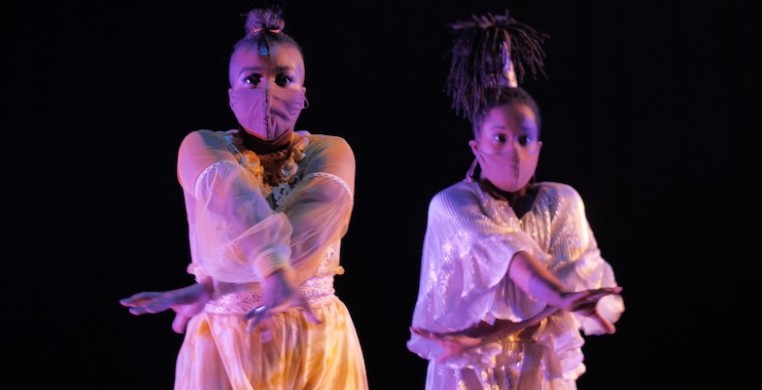Here is a heavy question: Is it possible for a human to be crushed under the tremendous weight of accumulated knowledge? Here is another one: Are we maintaining and growing a culture worthy for future generations to inherit, or are we just bickering tribes complicit in upholding a system of degrading and illusory “American” values? These are but some of the questions being asked by Red Clay Dance Company and they are like a slap in the face—more like a wake-up call than an act of violence. Fortunately for us, their latest show is not pulling any punches.
Red Clay became another victim of a sudden COVID cancellation when their last season was suddenly cut short by the pandemic. Instead of a slapdash, “We’re still here!” low-budget video, Red Clay took time to translate the modern dance works of director Vershawn Sanders-Ward, Lela Aisha Jones and Du’Bois A’Keen into a clean video production. Set on the dark, wide stage of the Harold Washington Cultural Center, the pre-taped, streamed performance of “Visions & Voices” aired Saturday on the company’s website.
There is no beating around the bush here. In “Visions,” Red Clay makes their intentions clear and thankfully ask more questions of their audience then they themselves answer, giving the viewer something to think about long after the show is over. The message of the performance is not only clear but spelled out to you—literally—over several screens of long text. After a single, hurried reading, I took it to mean that a deep knowledge of history blesses you with the burdens of acting in the present and taking responsibility for the future.
As I absorb and consider this textual blitz, the screen melts into a scene of roaming spotlights (searchlights?) with silhouetted human figures stealthily scraping across a blue and barren landscape to the looped drone of a disembodied voice. “Welcome to the divided states of America,” it says, only to be accosted by a gatekeeper, who offers them fruits of knowledge—shiny green apples that sometimes appear golden—should they perform worthily. But is this gatekeeper an oracle or a serpent? The opening piece, Sanders-Ward’s "Reckonings,” is blunt. And the costumes, red, white and blue baggy rompers, do well in their job of delineating a social identity to each dancer, no doubt influenced in the mind of the viewer by their own subjective internal politics. No one is portrayed as the bad guy, however, and the dancers pair up, indiscriminate of their costume color, sometimes matching each other in a low crawl and a dead stare, or with backs turned against one another while performing rotating roundhouse leaps, or simply one embracing the other. At one point, a white-clad dancer begins to hoard the fruit of knowledge and drops lower and lower to the ground the more weight they carry. It is a “careful what you wish for” scenario: Even more fruit is added to the dancer’s already bending frame—balanced on an arm or head, or stuck to the body—becoming statue-like, paralyzed and unmoving, held down by the enormous weight of unadulterated knowledge.
“We: all ~ gon’ die into revivals” is a premiere from Philadelphia-based choreographer Lela Aisha Jones and is an earth-oriented love letter to nature and naturalness. Set at first against somber and ambient solo piano music, the piece opens with an overhead view of two people mourning the two lifeless bodies lying next to them while a thin line of fabric is held horizontal over their heads by a pair of angels (or ancestors) with thick veils and wide-brimmed fedoras obscuring their features. Death is clearly an important theme in this work, as it is in nature, but there is also a lot of life here, too. When the full company enters, they are clutching their chests and pulsing with torsos near-parallel to the Earth, dancing around, behind and under—but seldom above—the spirits’ ever-present line. In the same breath, there are dancers with arms stretched in a begging gesture towards the sky while others perform short, recurring leitmotifs, hands as knives slicing downward as oppositional square knees rise above waist level, while others perform tight, furtive and bouncing body part isolations. At times, there is so much going on simultaneously that I am not sure where I am supposed to look, but the work manages to capture a fundamental aspect of existence—the tumbling into turmoil randomness that is nature.
The program ends with a premiere by New York-based choreographer Du’Bois A’Keen titled “Incarnation 1.” A proud matriarch—played with a dignified air by Marceia L Scruggs—decked in a flowing white robe leads a ghostly procession into view as the lights slowly warm around them. When the music heats up, so do the congregation, performing high fan kicks and quick body rolls across the length of the floor. At one point, all dancers are huddled in a far-back, overhead spotlight, seemingly searching for something in the darkness that surrounds them with drawn in and angular arm movements. The best part is a truly touching tête-à-tête between Scruggs and a less-experienced member of her followers, performing a call and response lesson in rhythm and flow that serves as a clear example of generational passing of wisdom. With the lesson over, the procession leaves while Scruggs remains, spent of spirit and stamina, to fade alone into the darkness.


